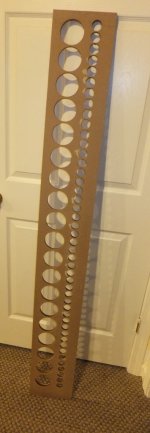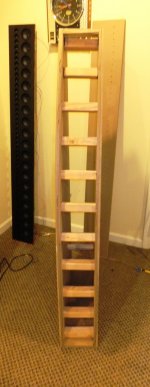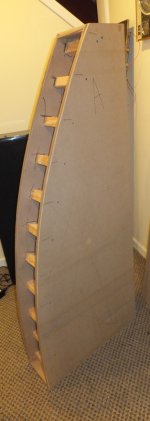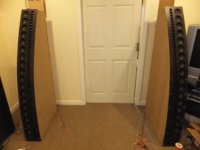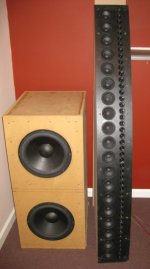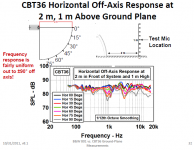So .. I built these. Lots of holes. I put them together as a prototype to see if I liked the concept.
Basically I tried to build a super low budget CBT36 clone. The drivers are the $1 Aura Neo specials and the $.50 Apex Jr. tweeters
There are 19 mids and 45 tweeters per side. There are two sealed NHT1259 woofers per side. I built the woofer cabinets 20 years ago to use with a set of Carver 60" ribbons (with a custom active crossover).
The cabinets match the original CBTs .. 5 feet tall with a 36 degree curve. The baffle is 1/2" MDF bent over the arc and screwed down every 10 inches.
I am using a modified DCX2496 for the crossover. Power for the prototype is from a pair of garage sale receivers .. a 100x5 Kenwood with direct inputs (running the mids and tweets) and an old Marantz driving the woofers.
Right now there is no shading. The woofers are wired in series/parallel (groups of three and four). The tweets are in five groups of nine.
On an Ohm meter, the tweeter array is about 8 Ohms, the woofers are 10 Ohms. Actual resistance is a little higher. The old Kenwood gets warm but has not shut itself down yet.
Tuning by ear I found that I like the woofers crossing at 150Hz with a 24dB Butterworth slope.
The mids cross to the tweeters at 6KHz with a 24dB LR. I added a 3KHz notch of about 4dB with the DCX EQ.
So .. I did this has an experiment and I would say that it surpassed my expectations.
First off . .the little Aura is a really nice driver. Very smooth, vocals sound great. The dynamics of the system are awesome. To quote an often used word .. effortless. None of these drivers are working very hard so distortion is low. The Auras are also carrying the bulk of the load. So you get the coherence goodness of an (almost) full range driver. The tweeters are really just helpers to add a little sparkle at the top. Without them, you could probably EQ the Aura line and be pretty happy.
And then there is the imaging. Sitting on the floor, sitting on the couch, standing up .. the sound never changes. Walk to one side of the room, still a nice stereo image. These have a giant sweet spot .. both horizontally and vertically.
At this point, I don't think I am going to play with the shading. Most listening is from the couch so "anywhere imaging" is not a big deal right now.
Next up is some measurements and more tweaking.
So here are some pics ...
Basically I tried to build a super low budget CBT36 clone. The drivers are the $1 Aura Neo specials and the $.50 Apex Jr. tweeters
There are 19 mids and 45 tweeters per side. There are two sealed NHT1259 woofers per side. I built the woofer cabinets 20 years ago to use with a set of Carver 60" ribbons (with a custom active crossover).
The cabinets match the original CBTs .. 5 feet tall with a 36 degree curve. The baffle is 1/2" MDF bent over the arc and screwed down every 10 inches.
I am using a modified DCX2496 for the crossover. Power for the prototype is from a pair of garage sale receivers .. a 100x5 Kenwood with direct inputs (running the mids and tweets) and an old Marantz driving the woofers.
Right now there is no shading. The woofers are wired in series/parallel (groups of three and four). The tweets are in five groups of nine.
On an Ohm meter, the tweeter array is about 8 Ohms, the woofers are 10 Ohms. Actual resistance is a little higher. The old Kenwood gets warm but has not shut itself down yet.
Tuning by ear I found that I like the woofers crossing at 150Hz with a 24dB Butterworth slope.
The mids cross to the tweeters at 6KHz with a 24dB LR. I added a 3KHz notch of about 4dB with the DCX EQ.
So .. I did this has an experiment and I would say that it surpassed my expectations.
First off . .the little Aura is a really nice driver. Very smooth, vocals sound great. The dynamics of the system are awesome. To quote an often used word .. effortless. None of these drivers are working very hard so distortion is low. The Auras are also carrying the bulk of the load. So you get the coherence goodness of an (almost) full range driver. The tweeters are really just helpers to add a little sparkle at the top. Without them, you could probably EQ the Aura line and be pretty happy.
And then there is the imaging. Sitting on the floor, sitting on the couch, standing up .. the sound never changes. Walk to one side of the room, still a nice stereo image. These have a giant sweet spot .. both horizontally and vertically.
At this point, I don't think I am going to play with the shading. Most listening is from the couch so "anywhere imaging" is not a big deal right now.
Next up is some measurements and more tweaking.
So here are some pics ...
Attachments
So the budget ...
Aurasound NS3-194-16A 3" Paper Cone 16 ohm ($1 each at 50pcs) plus shipping - $72 http://www.madisoundspeakerstore.com...r-cone-16-ohm/
Apex Jr. Tweeters - 100 @ $.50 each plus shipping - $62 Speaker Stuff
3/4" MDF for cabinets, 1/2" for baffles - $45
Hole saws for woofer and tweeter - $25
So for around $200 you can make yourself a pair of curved arrays that sound pretty darn good. Because the Aura cannot go as low as the ND91, I think that actual woofers (rather than subs) in stereo is the way to go. When I cross over at 80-100Hz, you can tell that some of the low end grunt is missing. Maybe an array of buyout 8's or 10's ... hmmmmmm.
Do they sound as good as the real CBT36s? I have no idea, never heard them. Would the shading make a big difference? Don't know. I don't think that it would help with the dynamic impact, seeing as most of the drivers are attenuated to some degree. My understanding is that the shading has the greatest impact on the vertical imaging .. something that I am not really concerned with.
So for 1/10th the price and a little more build effort, I don't think these are too far off the mark.
Many thanks to PE and Don Keele for publishing so much information about the originals.
Aurasound NS3-194-16A 3" Paper Cone 16 ohm ($1 each at 50pcs) plus shipping - $72 http://www.madisoundspeakerstore.com...r-cone-16-ohm/
Apex Jr. Tweeters - 100 @ $.50 each plus shipping - $62 Speaker Stuff
3/4" MDF for cabinets, 1/2" for baffles - $45
Hole saws for woofer and tweeter - $25
So for around $200 you can make yourself a pair of curved arrays that sound pretty darn good. Because the Aura cannot go as low as the ND91, I think that actual woofers (rather than subs) in stereo is the way to go. When I cross over at 80-100Hz, you can tell that some of the low end grunt is missing. Maybe an array of buyout 8's or 10's ... hmmmmmm.
Do they sound as good as the real CBT36s? I have no idea, never heard them. Would the shading make a big difference? Don't know. I don't think that it would help with the dynamic impact, seeing as most of the drivers are attenuated to some degree. My understanding is that the shading has the greatest impact on the vertical imaging .. something that I am not really concerned with.
So for 1/10th the price and a little more build effort, I don't think these are too far off the mark.
Many thanks to PE and Don Keele for publishing so much information about the originals.
Nice speaker! I have a similar proof-of-concept CBT with 26 Visaton SC5.9 drivers. Even thought the driver clearly has its issues, the CBT sounds very nice indeed. However, yours isn't really a CBT because there is no shading. Now it's just an arched, truncated line-array.
Nice indeed! There's been some hype about line arrays on our national audio forum, people building them all seem to be quite happy with them.
Very interesting to see you've build them with such cheap drivers. I love to build and experience first hand how different concepts sound & behave. If you can get good results with such cheap drivers then one of the drawbacks wich kept me from trying myself has been tackeled already. If only I could push myself to solder that manny drivers and tweeters 😀..
I'd love to see some measurements!
Greetings Reinder
Very interesting to see you've build them with such cheap drivers. I love to build and experience first hand how different concepts sound & behave. If you can get good results with such cheap drivers then one of the drawbacks wich kept me from trying myself has been tackeled already. If only I could push myself to solder that manny drivers and tweeters 😀..
I'd love to see some measurements!
Greetings Reinder
Nice work!,
you should really try the shading; it not only removes all sidelobes (which really helps with imaging), but also removes the strong combfiltering effect that you get on-axis due to the level jump that every unshaded line-array has (unless you go floor-to-ceiling).
I don't know if you're familiar with fourier transforms, but if you are; an un-shaded array is the same as a rectangular windowed fourier transform; not good for in-band ripple.
Window function - Wikipedia, the free encyclopedia
you should really try the shading; it not only removes all sidelobes (which really helps with imaging), but also removes the strong combfiltering effect that you get on-axis due to the level jump that every unshaded line-array has (unless you go floor-to-ceiling).
I don't know if you're familiar with fourier transforms, but if you are; an un-shaded array is the same as a rectangular windowed fourier transform; not good for in-band ripple.
Window function - Wikipedia, the free encyclopedia
We can look at Keele's measurements and comparison to B&W 801 here, at AudioArtistry website. I don't understand why Keele says that hor-polar is good???
CBT is exellent vertically but compromized horizontally. It shouldn't be too hard to get horizontal better.
Please!
CBT is exellent vertically but compromized horizontally. It shouldn't be too hard to get horizontal better.
Please!
Attachments
I agree, there's an off-axis dip at 1 kHz due to crossover lobing and a significant amount of diffraction, which is not surprising since the tiny tweeters act as point sources and the baffle lacks a radius.
Wow, so many, shoulda, coulda, wouldas from people. 😕
I think you did a terrific job on those speakers. I'm sure they sound great.
I heard the ones at Burning Amp and I was shocked by their sound, so many little drivers making such big sound!
I'm studying the design to try to make speakers like yours. I may use L-pads for shading, I don't know enough to not know enough. 🙂
The older design (like yours) has the larger footprint, the newer one is more of an arc attached to a stabilizer foot. Why did you choose the larger base?
I bought 80 of those same aura drivers, sweet deal ~$1.50 including shipping 🙂
Do you know / can you guess, what effect using 2/3 the number of tweeters but still centered in the middle of the arc would have? I've only got ~100 tweets and I wanted to build a center channel too. (different tweeters than you)
Have you tweaked them since your last post?
Thank you,
Ron
I think you did a terrific job on those speakers. I'm sure they sound great.
I heard the ones at Burning Amp and I was shocked by their sound, so many little drivers making such big sound!
I'm studying the design to try to make speakers like yours. I may use L-pads for shading, I don't know enough to not know enough. 🙂
The older design (like yours) has the larger footprint, the newer one is more of an arc attached to a stabilizer foot. Why did you choose the larger base?
I bought 80 of those same aura drivers, sweet deal ~$1.50 including shipping 🙂
Do you know / can you guess, what effect using 2/3 the number of tweeters but still centered in the middle of the arc would have? I've only got ~100 tweets and I wanted to build a center channel too. (different tweeters than you)
Have you tweaked them since your last post?
Thank you,
Ron
Yeah .. I don't understand some of the feedback ... but whatever .. I like them !
There are a few other people on here that have similar designs. There is one that grouped a shorter line of tweeters in the middle of the array and they liked them as well. Which tweeters are you using?
Not much more tweaking so far .. crossover points are the same. I have played with the EQ a bit but usually end up in the same place. I few dB down at 2-3K with a Q of about 2K on either side. Still need to get some measurements.
I went with the big boxes because it is easy 🙂 Basically I could take 2 - 2x5 sheets of MDF and create the curve on each side. Adding the back curve just added work.
Besides, this was and still is a proof of concept. Concept proven .. these kick *** for very little money. My plan is to eventually build better and more stylish cabinets. That is why only the baffle was painted.
There are a few other people on here that have similar designs. There is one that grouped a shorter line of tweeters in the middle of the array and they liked them as well. Which tweeters are you using?
Not much more tweaking so far .. crossover points are the same. I have played with the EQ a bit but usually end up in the same place. I few dB down at 2-3K with a Q of about 2K on either side. Still need to get some measurements.
I went with the big boxes because it is easy 🙂 Basically I could take 2 - 2x5 sheets of MDF and create the curve on each side. Adding the back curve just added work.
Besides, this was and still is a proof of concept. Concept proven .. these kick *** for very little money. My plan is to eventually build better and more stylish cabinets. That is why only the baffle was painted.
Yeah, I've spoken errr, texted to the builder (adason) of the white CBTs with the limited tweeters in the middle. He loves his too.
I bought about 100 1" Tweeters of unknown manufacture from Zero Cool.
Man, trying to figure out the wiring to get ~8Ohms from all those speakers can make you NUTS. I know that there is a way to run them in series and parallel to achieve the shading effect, but I'm a woodworker not an engineer. I was just going to put in a few L-pads, maybe, we'll see. 🙂 Thinking of 18 per speaker.
Any Tips?
Ron
I bought about 100 1" Tweeters of unknown manufacture from Zero Cool.
Man, trying to figure out the wiring to get ~8Ohms from all those speakers can make you NUTS. I know that there is a way to run them in series and parallel to achieve the shading effect, but I'm a woodworker not an engineer. I was just going to put in a few L-pads, maybe, we'll see. 🙂 Thinking of 18 per speaker.
Any Tips?
Ron
I could not figure out the shading math .. so that is why I skipped it. I have the woofers grouped in sets of 3 and 4 and the tweeters are 5 banks of 9. Each set of drivers works out to about 12 ohms. Not ideal, but they don't need a lot of power so the amp does not seem to have a problem with it.
The shading on the real CBTs is mostly to control the vertical pattern .. but I listen mostly from the sweet spot on my couch so I was not really concerned. Also, when sitting down, most of the CBT drivers firing at you are at full power. It might be better to think of these as a line array with the curve helping to reduce comb filtering.
One thing I really love is the dynamics of this system. It never seems to be straining when cranked up. I was worried that the super cheap tweeters would sound harsh, but they are very sweet at the crossover point. They do start to get ugly if I drop below 6K, but the little Aura mids have no trouble stretching up there so its all good.
Right now I have the speakers about 15' apart and I think that is too much. Some sounds like tom fills are a little too big went stretched across the room. The imaging is very good with these, so I may push them closer together so the soundstage is not sooo huge.
I would like to put together a passive crossover between the tweeters and mids .. then go active to the woofers. That way I could use the $80 MiniDSP and free up my DCX for other things 🙂
The shading on the real CBTs is mostly to control the vertical pattern .. but I listen mostly from the sweet spot on my couch so I was not really concerned. Also, when sitting down, most of the CBT drivers firing at you are at full power. It might be better to think of these as a line array with the curve helping to reduce comb filtering.
One thing I really love is the dynamics of this system. It never seems to be straining when cranked up. I was worried that the super cheap tweeters would sound harsh, but they are very sweet at the crossover point. They do start to get ugly if I drop below 6K, but the little Aura mids have no trouble stretching up there so its all good.
Right now I have the speakers about 15' apart and I think that is too much. Some sounds like tom fills are a little too big went stretched across the room. The imaging is very good with these, so I may push them closer together so the soundstage is not sooo huge.
I would like to put together a passive crossover between the tweeters and mids .. then go active to the woofers. That way I could use the $80 MiniDSP and free up my DCX for other things 🙂
I could not figure out the shading math .. so that is why I skipped it. I have the woofers grouped in sets of 3 and 4 and the tweeters are 5 banks of 9. Each set of drivers works out to about 12 ohms. Not ideal, but they don't need a lot of power so the amp does not seem to have a problem with it.
<snip>
Happened across this thread from the other thread on the CBT...
...thought I'd mention that if you have the groups of drivers wired as "3 OR 4" then you do not have equal amplitude on both groups! Regardless of the fact that when all wired together you get a reasonable impedance.
This assumes too that you have wired them so that they are ALL in the same series/parallel arrangement. That would be required IF they were all in identical groupings.
If the drivers in each group are in parallel, then because each group is effectively a different impedance there is a difference in current drawn, so a difference in power. This becomes obvious when one compares a group of 4 in parallel to a single driver... the voltage presented to each group is the same coming from the amplifier.
If each group is in series then the group of 4 has a higher impedance, and less power drawn, which is then divided 4 ways. The group of 3 has more power drawn (lower Z) and divided 3 ways.
One solution for a situation where the total number of drivers does not happen to divide nicely is to take the "remainder" drivers, put them at the end of the array and use some resistors to approximate the requisite impedance (essentially a "dummy" speaker in the group).
If I remember correctly, the bottom three drivers are a set of 3 in series and the rest are in sets of 4. I realize that the less drivers in the series group, the louder those drivers will be. I think that is why the group of 3 is on the bottom (a quick and dirty attempt at shading). My other option was to do 5 groups of 4 and put the 20th driver inside the cabinet.
As I said, these were prototypes to see if the concept worked. As it turns out, they sound so good that I have little incentive to tear them apart and try to make them 'better' or 'more like the real CBTs'.
What is really sad is that I still need to put proper back panels on them,flush trim everything, and paint the sides.
As I said, these were prototypes to see if the concept worked. As it turns out, they sound so good that I have little incentive to tear them apart and try to make them 'better' or 'more like the real CBTs'.
What is really sad is that I still need to put proper back panels on them,flush trim everything, and paint the sides.
Ummm, don't put the 20th *in* the box, use a resistor??
Or add a resistor to the 3 in the bottom...
Or maybe the cabinet ought to have been made one hole taller??
But if they sound good and you don't pound the SPLs/power it probably won't matter...
Or add a resistor to the 3 in the bottom...
Or maybe the cabinet ought to have been made one hole taller??
But if they sound good and you don't pound the SPLs/power it probably won't matter...
The shading is important, according to Keele. Don said that each driver should, in theory, get its own attenuation. But for practical matters he did them by groups in the actual build.
Bear,
Damn it! You made me feel sooooo dumb with your last post. I spent more than a few hours on Saturday trying to figure out how to get 18 drivers @ 16 Ohms each to end up at 16 Ohms. Duh. (takes keys out of ear) // a 32 Ohm R! Awesome. Brilliant! Thank you!
Q: Should I measure the real speaker inductance and then just double it? or should I just use a 32R0 ?
As I stated earlier, I am planning on passive XOs . 16 Ohm set of woofers // 16 Ohm set of tweeters. Perfect 8 Ohms.
Pano,
I plan on shading my arrays, using an L-pad per each set of (4)drivers +2. 🙂 Well not the first (from the bottom) 2 sets of woofers. Close enough to 40%.
I'm sooooo happy.
Thanks Ron
Damn it! You made me feel sooooo dumb with your last post. I spent more than a few hours on Saturday trying to figure out how to get 18 drivers @ 16 Ohms each to end up at 16 Ohms. Duh. (takes keys out of ear) // a 32 Ohm R! Awesome. Brilliant! Thank you!
Q: Should I measure the real speaker inductance and then just double it? or should I just use a 32R0 ?
As I stated earlier, I am planning on passive XOs . 16 Ohm set of woofers // 16 Ohm set of tweeters. Perfect 8 Ohms.
Pano,
I plan on shading my arrays, using an L-pad per each set of (4)drivers +2. 🙂 Well not the first (from the bottom) 2 sets of woofers. Close enough to 40%.
I'm sooooo happy.
Thanks Ron
Last edited:
Well there are reasons to go with say a 4 ohm total Z for the array.
You gain sensitivity with paralleled drivers.
The faked drivers being a resistor should be the nominal Z above the resonant frequency bump... ur up above that frequency anyhow I expect.
One could do an empirical test by putting an SPL meter in front of a single set of drivers, measure, then trim the R to meet the same SPL in the shorted set.
So let me see if I can figure it out.
Sets of 3 drivers gives you 6 sets. You can wire them as parallel or series sets.
If parallel sets you will get 5.3 ohms per set. So, 3 sets in series, then in parallel with the other 3 sets in series gets you 8 ohms at the speaker terminals...
Or you can put 3 sets in parallel, then put the other 3 sets in series with that, and 8 ohms...
There are other variations possible, but since 3 sets of 3 is 9 drivers you'll be hard pressed to get 1/2 driver... unless you use an extra resistor to simulate more drivers.
Also 16 ohm woofers & 16 ohm tweeters still gets you a 16 ohm speaker system.
You could shade the array by changing the number of drivers per "set". A bit depends on what is called for in terms of DB drop per distance from the "center".
You do NOT want to parallel a 32ohm resistor with a 32ohm array because that drops you 1/2 power to the speakers immediately. Your amp can drive a 32 ohm load all day long, no problem. You can also build a suitable xover for the 16 ohm tweeter array and have the amp drive it ok fine... of course if the tweeters happen to bee "too hot" anyhow one could consider dropping in a series resistor, but I'd opt for a separate amp for the tweeters no matter what, so you can precisely set the levels and have nil interactions.
You gain sensitivity with paralleled drivers.
The faked drivers being a resistor should be the nominal Z above the resonant frequency bump... ur up above that frequency anyhow I expect.
One could do an empirical test by putting an SPL meter in front of a single set of drivers, measure, then trim the R to meet the same SPL in the shorted set.
So let me see if I can figure it out.
Sets of 3 drivers gives you 6 sets. You can wire them as parallel or series sets.
If parallel sets you will get 5.3 ohms per set. So, 3 sets in series, then in parallel with the other 3 sets in series gets you 8 ohms at the speaker terminals...
Or you can put 3 sets in parallel, then put the other 3 sets in series with that, and 8 ohms...
There are other variations possible, but since 3 sets of 3 is 9 drivers you'll be hard pressed to get 1/2 driver... unless you use an extra resistor to simulate more drivers.
Also 16 ohm woofers & 16 ohm tweeters still gets you a 16 ohm speaker system.
You could shade the array by changing the number of drivers per "set". A bit depends on what is called for in terms of DB drop per distance from the "center".
You do NOT want to parallel a 32ohm resistor with a 32ohm array because that drops you 1/2 power to the speakers immediately. Your amp can drive a 32 ohm load all day long, no problem. You can also build a suitable xover for the 16 ohm tweeter array and have the amp drive it ok fine... of course if the tweeters happen to bee "too hot" anyhow one could consider dropping in a series resistor, but I'd opt for a separate amp for the tweeters no matter what, so you can precisely set the levels and have nil interactions.
Rhubarb,
Did you kerf the backside of the MDF baffle to make the curve? If so, how deep was the kerf?
Ron
Did you kerf the backside of the MDF baffle to make the curve? If so, how deep was the kerf?
Ron
So the budget ...
Aurasound NS3-194-16A 3" Paper Cone 16 ohm ($1 each at 50pcs) plus shipping - $72 http://www.madisoundspeakerstore.com...r-cone-16-ohm/
Apex Jr. Tweeters - 100 @ $.50 each plus shipping - $62 Speaker Stuff
3/4" MDF for cabinets, 1/2" for baffles - $45
Hole saws for woofer and tweeter - $25
So for around $200 you can make yourself a pair of curved arrays that sound pretty darn good. Because the Aura cannot go as low as the ND91, I think that actual woofers (rather than subs) in stereo is the way to go. When I cross over at 80-100Hz, you can tell that some of the low end grunt is missing. Maybe an array of buyout 8's or 10's ... hmmmmmm.
Do they sound as good as the real CBT36s? I have no idea, never heard them. Would the shading make a big difference? Don't know. I don't think that it would help with the dynamic impact, seeing as most of the drivers are attenuated to some degree. My understanding is that the shading has the greatest impact on the vertical imaging .. something that I am not really concerned with.
So for 1/10th the price and a little more build effort, I don't think these are too far off the mark.
Many thanks to PE and Don Keele for publishing so much information about the originals.
I've heard the CBT36, had the pleasure of meeting Don Keele, and I have some ND91s and those paper cone Aurasounds sitting here. Some random observations:
1) I think the ND91 sounds about a million times better than the paper cone Aurasound. But the main problem with the NS3-194-16A is that it's grungey, and that 'grunge' may very well be harmonic distortion. So using a big pile of 'em may be a very good solution! In fact, the expense of the ND91 may be overkill in an array.
I've tried a bunch of the Aurasound drivers, and those paper cone ones are an odd item. Nearly everything that Aurasound sells has a ton of excursion, but for some reason, those paper cone drivers don't. But again, array 'em and you may well have solved the problem.
2) I've never heard an array that I liked, and the CBT36 sounded no better to me than any of the other ones I've heard. I really had high hopes, as I've studied Keele obsessively, but it just seems like a flawed concept to me. (The flaw in the CBT is the interference between the tweeters; the only way that the tweeters in the CBT will work properly would be if they had very wide directivit in the horizontal axis and very narrow directivity in the vertical axis. Unless you satisfy that requirement, you're not going to get the high frequencies to radiate in the way that the paper proposes.)
An externally hosted image should be here but it was not working when we last tested it.
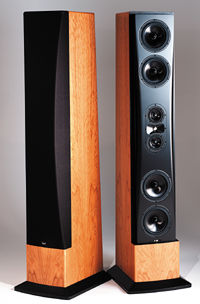
3) One way to 'fix' the CBT would be to do what Smith did in the xPanding Array. Take the array and segment it into highs, mids, and lows. According to LinkedIn, David Smith and Don Keele were working at JBL at the same time, back in the early 80s. Kind of interesting how their designs have evolved.
Last edited:
We can look at Keele's measurements and comparison to B&W 801 here, at AudioArtistry website. I don't understand why Keele says that hor-polar is good???
CBT is exellent vertically but compromized horizontally. It shouldn't be too hard to get horizontal better.
Please!
My educated guess on why the horizontal polars are bad is because of the directivity mismatch at the crossover frequency, which is exacerbated by the fact that the midrange and the tweeter are on the same axis. (IE, the reason that we put our tweeters above our midranges in a conventional speaker is because doing that improves the frequency response along the horizontal axis.)
1/2" Dome Tweeter Element 10 Pcs. 275-010
What might be an interesting solution would be to take about fifty of the tweeters alone, and mount them on a sphere. By putting them on sphere, you take the idea of the CBT - the curved radiation - and you take it to the next level. A pulsing sphere of sound.
You basically have zero diffraction, no crossover, full range spherical radiation.
Fifty tweeters might sound like overkill, but they have an efficiency of 66dB, so fifty of them will get your output level up to 103dB per speaker. Not terribly high, but probably good enough.
A hundred of the drivers would be about $250 at Parts Express.
- Status
- Not open for further replies.
- Home
- Loudspeakers
- Multi-Way
- Building some CBT clones ...
